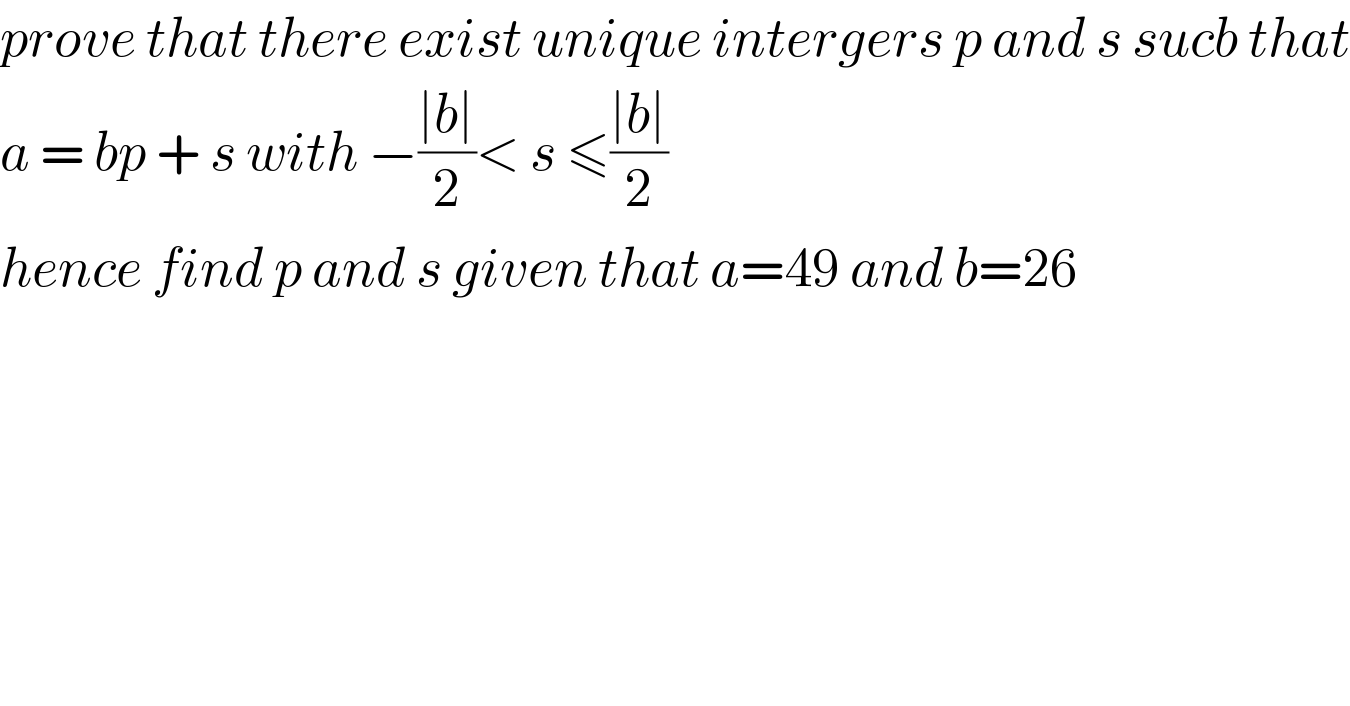
Question Number 63532 by Rio Michael last updated on 05/Jul/19

$${prove}\:{that}\:{there}\:{exist}\:{unique}\:{intergers}\:{p}\:{and}\:{s}\:{sucb}\:{that} \\ $$ $${a}\:=\:{bp}\:+\:{s}\:{with}\:−\frac{\mid{b}\mid}{\mathrm{2}}<\:{s}\:\leqslant\frac{\mid{b}\mid}{\mathrm{2}} \\ $$ $${hence}\:{find}\:{p}\:{and}\:{s}\:{given}\:{that}\:{a}=\mathrm{49}\:{and}\:{b}=\mathrm{26} \\ $$
Answered by MJS last updated on 05/Jul/19
![a=bp+s ⇒ s=a−bp case 1: b>0 −(b/2)<a−bp≤(b/2) (a/b)−(1/2)≤p<(a/b)+(1/2) case 2: b<0 (b/2)<a−bp≤(b/2) (a/b)−(1/2)<p≤(a/b)+(1/2) in both cases: the width of the interval [(a/b)−(1/2); (a/b)+(1/2)] is 1 ⇒ ⇒ there′s exactly one p∈Z∧((a/b)−(1/2)≤p<(a/b)+(1/2)∨(a/b)−(1/2)<p≤(a/b)+(1/2)) ⇒ s is also unique a=49∧b=26 ((49)/(26))−(1/2)≤p<((49)/(26))+(1/2) ((18)/(13))≤p<((31)/(13)) ⇒ p=2 s=a−bp=49−26×2=−3](Q63545.png)
$${a}={bp}+{s}\:\Rightarrow\:{s}={a}−{bp} \\ $$ $$\mathrm{case}\:\mathrm{1}:\:{b}>\mathrm{0} \\ $$ $$−\frac{{b}}{\mathrm{2}}<{a}−{bp}\leqslant\frac{{b}}{\mathrm{2}} \\ $$ $$\frac{{a}}{{b}}−\frac{\mathrm{1}}{\mathrm{2}}\leqslant{p}<\frac{{a}}{{b}}+\frac{\mathrm{1}}{\mathrm{2}} \\ $$ $$\mathrm{case}\:\mathrm{2}:\:{b}<\mathrm{0} \\ $$ $$\frac{{b}}{\mathrm{2}}<{a}−{bp}\leqslant\frac{{b}}{\mathrm{2}} \\ $$ $$\frac{{a}}{{b}}−\frac{\mathrm{1}}{\mathrm{2}}<{p}\leqslant\frac{{a}}{{b}}+\frac{\mathrm{1}}{\mathrm{2}} \\ $$ $$\mathrm{in}\:\mathrm{both}\:\mathrm{cases}: \\ $$ $$\mathrm{the}\:\mathrm{width}\:\mathrm{of}\:\mathrm{the}\:\mathrm{interval}\:\left[\frac{{a}}{{b}}−\frac{\mathrm{1}}{\mathrm{2}};\:\frac{{a}}{{b}}+\frac{\mathrm{1}}{\mathrm{2}}\right]\:\mathrm{is}\:\mathrm{1}\:\Rightarrow \\ $$ $$\Rightarrow\:\mathrm{there}'\mathrm{s}\:\mathrm{exactly}\:\mathrm{one}\:{p}\in\mathbb{Z}\wedge\left(\frac{{a}}{{b}}−\frac{\mathrm{1}}{\mathrm{2}}\leqslant{p}<\frac{{a}}{{b}}+\frac{\mathrm{1}}{\mathrm{2}}\vee\frac{{a}}{{b}}−\frac{\mathrm{1}}{\mathrm{2}}<{p}\leqslant\frac{{a}}{{b}}+\frac{\mathrm{1}}{\mathrm{2}}\right) \\ $$ $$\Rightarrow\:{s}\:\mathrm{is}\:\mathrm{also}\:\mathrm{unique} \\ $$ $$ \\ $$ $${a}=\mathrm{49}\wedge{b}=\mathrm{26} \\ $$ $$\frac{\mathrm{49}}{\mathrm{26}}−\frac{\mathrm{1}}{\mathrm{2}}\leqslant{p}<\frac{\mathrm{49}}{\mathrm{26}}+\frac{\mathrm{1}}{\mathrm{2}} \\ $$ $$\frac{\mathrm{18}}{\mathrm{13}}\leqslant{p}<\frac{\mathrm{31}}{\mathrm{13}}\:\Rightarrow\:{p}=\mathrm{2} \\ $$ $${s}={a}−{bp}=\mathrm{49}−\mathrm{26}×\mathrm{2}=−\mathrm{3} \\ $$
